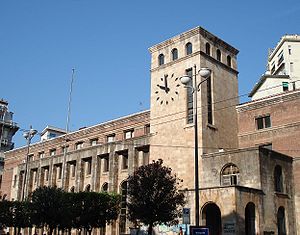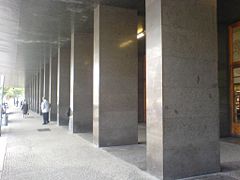
Angiolo Mazzoni
Encyclopedia

Angiolo Mazzoni was a prolific state architect and engineer of the Italian Fascist government of the 1920s and 1930s.
Mazzoni designed hundreds of public buildings, post offices and train stations during the Interwar period
Interwar period
Interwar period can refer to any period between two wars. The Interbellum is understood to be the period between the end of the Great War or First World War and the beginning of the Second World War in Europe....
in Italy. After many years of neglect by architectural critics, his legacy is re-emerging as a significant Italian architect of the modern period.
Life
Mazzoni was born in BolognaBologna
Bologna is the capital city of Emilia-Romagna, in the Po Valley of Northern Italy. The city lies between the Po River and the Apennine Mountains, more specifically, between the Reno River and the Savena River. Bologna is a lively and cosmopolitan Italian college city, with spectacular history,...
, was moved to Rome in 1905 with his parents, but returned to the Academy of Fine Arts, Bologna for his education. In 1920 Mazzoni practiced for about a year under Marcello Piacentini
Marcello Piacentini
Marcello Piacentini was an Italian architect and urban theorist.-Biography:Born in Rome, he was the son of architect Pio Piacentini...
. The following year he was engaged as an engineer with the Special Section of Railway Workers in Milan, then rose to a position in the newly formed Ministry of Communications
Ministry of Communications (Italy)
The Ministry of Communications was a government ministry of the Republic of Italy, dealing with postal, telephone, telegraph and electronic communications, journalistic information and commercial advertising. Set up in 1924, since the Berlusconi IV Cabinet of 2008 it has been subsumed into the...
in 1924, producing significant independent work by 1926.
Politically astute, Mazzoni also joined the National Fascist Party
National Fascist Party
The National Fascist Party was an Italian political party, created by Benito Mussolini as the political expression of fascism...
in 1926. He owed much of his success and influence to his intimate connections with the Fascist regime, and played a decisive role in using architecture to consolidate positive images of Fascism.
The Fascist regime engaged in a comprehensive national program of public works. As chief architect for the Ministry of Communications and for the State Railways, both key modernizing sectors of Fascist rebuilding programs, Mazzoni designed many of them. Italy still contains hundreds of his large and small railway and telecommunications buildings, extant and functioning, a tribute to his mastery of robust, hard-working construction. In many of these he collaborated with architect and engineer Roberto Narducci
Roberto Narducci
Roberto Narducci was an Italian architect and engineer of the Modernist and Novocento movements.-Life:...
.
Mazzoni's relationship with Fascism made it politically difficult for subsequent scholars to acknowledge his importance. Construction on his major commission, the vast Roma Termini railway station
Roma Termini railway station
Roma Termini is the main train station of Rome. It is named after the district of the same name, which in turn took its name from ancient Baths of Diocletian , which lie across the street from the main entrance.-Overview:The station has regular train services to all major Italian cities as well...
, was suspended in wartime Italy and redesigned by others after the Fascist defeat. Other important buildings by Mazzoni were crudely altered or demolished in the post-war period. His own personal advocacy of Fascism worked against his legacy, even after the end of the World War II
World War II
World War II, or the Second World War , was a global conflict lasting from 1939 to 1945, involving most of the world's nations—including all of the great powers—eventually forming two opposing military alliances: the Allies and the Axis...
when he voluntarily exiled himself in Bogota, Colombia utnil 1963.
More recently academics and scholars such as Ezio Godoli, Giorgio Muratore, and Enrico Crispolti have begun a rehabilitation process and a critical re-evaluation of Mazzoni. His archive is now kept at the Museum of Modern Art in Trento, and efforts are being made to ensure the conservation of his most important surviving buildings.
Work
Stylistically conservative, Mazzoni never joined any of the Italian modern movement groups. He did had however significant links to "seconda maniera" (second wave) Futurism centered around F.T. MarinettiFilippo Tommaso Marinetti
Filippo Tommaso Emilio Marinetti was an Italian poet and editor, the founder of the Futurist movement, and a fascist ideologue.-Childhood and adolescence:...
, for instance co-authorizng the Manifesto of Aerial Architecture with its echoes of the Fascist / Futurist aeropittura
Aeropittura
Aeropittura was a major expression of the second generation of Italian Futurism, from 1929 through the early 1940s. The technology and excitement of flight, directly experienced by most aeropainters, offered aeroplanes and aerial landscape as new subject matter.Aeropainting was surprisingly...
movement. Mazzoni's work also shows connections to the Viennese School of Josef Hoffman and Otto Wagner
Otto Wagner
Otto Koloman Wagner was an Austrian architect and urban planner, known for his lasting impact on the appearance of his home town Vienna, to which he contributed many landmarks.-Life:...
, and a neo-classical influence.
Throughout his work, his stylistic approach varied dramatically, from the overtly bombastic and classical to the dynamically modern. In every case, his handling of composition, solids and voids, light and shade, surfaces and materials, was originally conceived, spirited, poetic, erudite, strong, and full of conviction.
Mazzoni's work includes:
- Venezia Santa Lucia railway stationVenezia Santa Lucia railway stationVenezia Santa Lucia railway station is a terminal station serving the comune of Venice, Italy. It is also the only railway station in the historic city of Venice ....
(designed 1924, built 1934-1943, completed postwar) - monumental post office in Palermo (1926-1934)
- reconstruction of the Bolzano/Bozen railway stationBolzano/Bozen railway stationBolzano/Bozen railway station serves the city and comune of Bolzano-Bozen, in the autonomous region of Trentino-Alto Adige/Südtirol, northeastern Italy...
, with architectural sculpture by Italian sculptor Franz Ehrenhöfer (1927-1929) - "Palace of Post and Telegraphs", GrossetoGrossetoGrosseto is a city and comune in the central Italian region of Tuscany, the capital of the Province of Grosseto. The city lies 14 km from the Tyrrhenian Sea, in the Maremma, at the centre of an alluvial plain, on the Ombrone river....
, with architectural sculpture by Italian sculptor Napoleone Martinuzzi (1930) - the railway station of LatinaLatina railway stationLatina is the main railway station of the Italian city of Latina, in the region of Lazio. It is owned by the Ferrovie dello Stato, the national rail company of Italy, and is an important train station of its region.-Geography:...
(1932) - central post office, GoriziaGoriziaGorizia is a town and comune in northeastern Italy, in the autonomous region of Friuli Venezia Giulia. It is located at the foot of the Julian Alps, bordering Slovenia. It is the capital of the Province of Gorizia, and it is a local center of tourism, industry, and commerce. Since 1947, a twin...
(1932) - the Siena railway stationSiena railway stationSiena railway station serves the city and comune of Siena, in the region of Tuscany, central Italy. Opened in 1935, it forms part the Central Tuscany railway , and is a junction station for a branch line to Grosseto....
(1933–35) - the railway station of Montecatini Terme (1933–37)
- the boiler house, control cabinHeating plant and main controls cabin, FlorenceThe Heating plant and Main controls cabin is a technical facilities building in Firenze Santa Maria Novella railway station designed by architect Angiolo Mazzoni in 1929...
and personnel facilities at Firenze Santa Maria Novella railway station (1934) - the Reggio Emilia railway stationReggio Emilia railway stationReggio Emilia railway station serves the city and comune of Reggio Emilia, in the region of Emilia-Romagna, northern Italy. Opened in 1859, it forms part of the Milan–Bologna railway, and is also a terminus of three secondary railways, linking Reggio Emilia with Ciano d'Enza, Guastalla and...
(circa 1935) - Roma Tiburtina railway stationRoma Tiburtina railway stationRoma Tiburtina is the second largest railway station in Rome, after Roma Termini. Located in the north-eastern part of the city, it is being redeveloped as a hub for the Italian high speed rail services instead of Termini, which is a terminal station....
(1937) - the central railway station of Reggio CalabriaReggio Calabria Centrale railway stationReggio Calabria Centrale is the main railway station of the Italian city of Reggio, in Calabria. It is the most important station of its region and is owned by the Ferrovie dello Stato, the national rail company of Italy.-History:...
(1938) - the central railway station of MessinaMessina Centrale railway stationMessina Centrale is the main railway station of the Italian city of Messina, in Sicily. As Palermo Centrale, Catania Centrale and Syracuse it is one of the most important stations of its region...
(1939) - Roma Termini railway stationRoma Termini railway stationRoma Termini is the main train station of Rome. It is named after the district of the same name, which in turn took its name from ancient Baths of Diocletian , which lie across the street from the main entrance.-Overview:The station has regular train services to all major Italian cities as well...
(circa 1940, unfinished and work abandoned circa 1943)
Trento's Railway Station
One classic example of Mazzoni's work is the railway stationTrento railway station
Trento railway station serves the city and comune of Trento, capital of the autonomous region of Trentino-Alto Adige/Südtirol, northeastern Italy. Opened in 1859, it forms part of the Brenner railway , and is also a junction with the Valsugana railway, which connects Trento with Venice.The...
in Trento
Trento
Trento is an Italian city located in the Adige River valley in Trentino-Alto Adige/Südtirol. It is the capital of Trentino...
, a city in the north-eastern Italian Alps, built during 1934–36. Trento had a special significance for the Fascist regime as the capital of the Trentino-Alto Adige (Welschtirol-Südtirol) region, annexed to Italy from Austria at the Treaty of Versailles after World War I. Mazzoni was born close to Trento.

Functionalism (architecture)
Functionalism, in architecture, is the principle that architects should design a building based on the purpose of that building. This statement is less self-evident than it first appears, and is a matter of confusion and controversy within the profession, particularly in regard to modern...
style typical of the times; the building's continuous windows and dynamic structural lines are said to express Futurist ideas of speed and streamlining. The station stands out due to its innovative use of steel, glass, and several varieties of local stone.
The station offers platforms on four rail tracks and its design is intended to facilitate the flow of people from the street to the trains. Wide wood-frame doors open on the entire facade. A wide, shallow staircase leads to the underpassage to the 2nd and 3rd tracks. Spacious waiting space is provided under cover or indoor.
In addition to ticket offices, a tobacconist, a news-stand and baggage store, the station also provided office space for administration, restrooms, a restaurant and bar (today only a bar remains) and conference rooms and meeting space. Mazzoni was more than an architect. He also was an important interior and furniture designer, and all the components of his buildings, from wall decorations to brass door-handles and glazed screens, were designed by his office. The main hall of Trento railway station was decorated with large mosaics depicting the life of the people, and the natural beauties of the mountainous region around Trento. These depictions were typical of the time and served an educational-propagandistic purpose. Originally, the ceiling is said to have been painted light green.

